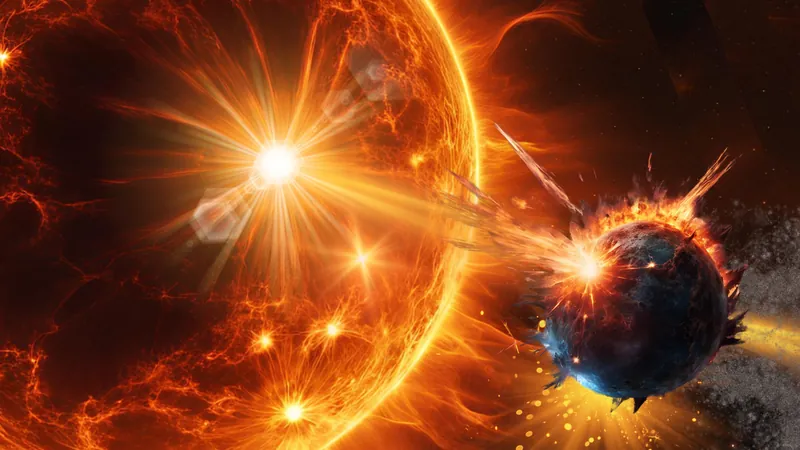
NASA Discovers Fastest Disintegrating Planet: A Cosmic Bizarre Event!
2025-01-17
Author: Wei Ling
Introduction
In an astonishing revelation, astronomers using NASA's Transiting Exoplanet Survey Satellite (TESS) have identified the fastest disintegrating planet ever observed in the cosmos. Named BD+05 4868 Ab, this planet is crumbling at an unprecedented rate, losing a “moon's worth” of material every million years due to extreme bombardment from its parent star. Alarmingly, BD+05 4868 Ab is on a path to complete annihilation.
Location and Significance
Located approximately 141 light-years away, BD+05 4868 Ab is the closest disintegrating exoplanet known to scientists. This uncanny situation presents a unique opportunity for astronomers. The disintegration allows researchers to explore the hidden interiors of terrestrial worlds that are typically difficult to study, offering insights into planetary composition and evolution.
Research Teams and Observations
Currently, two research teams, one led by the Massachusetts Institute of Technology (MIT) that discovered the planet and another from Penn State University, are gearing up to peer deeper into this celestial mystery using the powerful James Webb Space Telescope (JWST). Their goal is to unlock the secrets behind BD+05 4868 Ab and learn more about its unusual characteristics.
Nick Tusay, leader of the Penn State team, expressed the excitement surrounding this project, stating, "These planets are literally spilling their guts into space for us, and with JWST, we finally have the means to study their composition and see what planets orbiting other stars are really made of."
Presentation at American Astronomical Society Meeting
Both research teams recently showcased their finding at the 245th meeting of the American Astronomical Society in National Harbor, Maryland. Jason Wright, a member of the Penn State team, highlighted the rarity of such an occurrence, stating, "It's remarkable that directly measuring the interior of planets in the solar system is so challenging... but here we have found planets hundreds of light-years away that are sending their interiors into space."
Methodology of Observation
Through a method known as transiting, the teams observed BD+05 4868 Ab as it crossed in front of its star, causing a slight dimming in starlight that signaled the presence of the planet. This technique, coupled with spectroscopy—which analyzes light absorption patterns—enables astronomers to decode the elemental makeup of the planet’s atmosphere and the debris surrounding it.
Characteristics of BD+05 4868 Ab
Interestingly, BD+05 4868 Ab is classified as an “ultra-short period” planet, orbiting its star in just 30.5 hours. Such planets are incredibly rare; before the discovery of BD+05 4868 Ab, only three disintegrating planets had been recorded amongst over 6,000 entries in NASA's exoplanet catalog.
Unique Dust Trails
The chaos surrounding this planet creates a dynamic environment where material is expelled at a high rate, forming a prominent trail of dust reminiscent of a comet's tail. Marc Hon, the MIT team leader, remarked on this unique feature, "The disintegrating planet orbiting BD+05 4868 A has the most prominent dust tails to date. The dust tails emanating from the rapidly evaporating planet are gigantic, stretching about 5.6 million miles (9 million kilometers) long and encircling over half the planet’s orbit every 30.5 hours."
Structure of Dust Trails
This dust trail is intricately structured, containing larger grains in the front section and finer grains trailing behind. The sheer size and density of the dust are significant, blocking 1% of the star's light when the tail passes in front, creating a transit signal lasting an impressive 15 hours.
Final Observation of BD+05 4868 Ab
As BD+05 4868 Ab continues to lose its mass at this cataclysmic rate, researchers are aware that they are witnessing the final moments of a dying world. "We are incredibly lucky to be witnessing the final hours of this dying planet," said Hon.
Future Research and Questions
Astronomers are eagerly awaiting the findings that will emerge from the JWST, which promises to unveil the secrets locked within this shattered world and expand our understanding of planetary systems across the universe. What revelations will this cosmic inquiry reveal? Stay tuned as we explore the mysteries of distant worlds!


 Brasil (PT)
Brasil (PT)
 Canada (EN)
Canada (EN)
 Chile (ES)
Chile (ES)
 Česko (CS)
Česko (CS)
 대한민국 (KO)
대한민국 (KO)
 España (ES)
España (ES)
 France (FR)
France (FR)
 Hong Kong (EN)
Hong Kong (EN)
 Italia (IT)
Italia (IT)
 日本 (JA)
日本 (JA)
 Magyarország (HU)
Magyarország (HU)
 Norge (NO)
Norge (NO)
 Polska (PL)
Polska (PL)
 Schweiz (DE)
Schweiz (DE)
 Singapore (EN)
Singapore (EN)
 Sverige (SV)
Sverige (SV)
 Suomi (FI)
Suomi (FI)
 Türkiye (TR)
Türkiye (TR)
 الإمارات العربية المتحدة (AR)
الإمارات العربية المتحدة (AR)